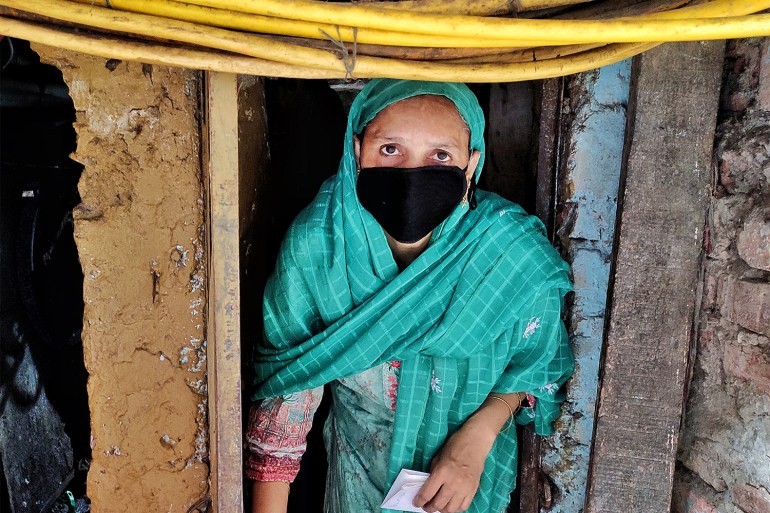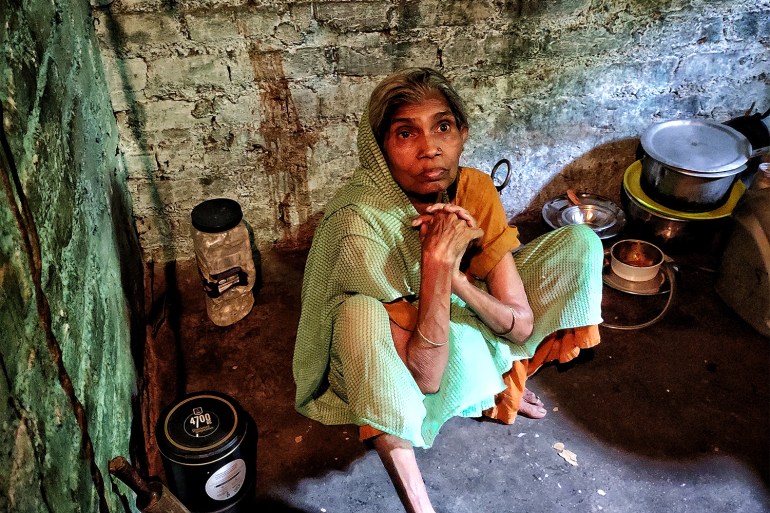New Delhi, India – Tabassum Nisha life in a shanty in a cramped corner of New Delhi’s Malviya Nagar neighbourhood with her 5 youngsters.
The 38-yr-old widow, who worked as a housemaid, employed to endure on a every month profits of $50 when she needed extra than two times that amount to feed her little ones.
Hardly in a position to make finishes fulfill, Nisha missing her work when a unexpected lockdown was introduced by the Indian govt in March past calendar year to consist of the coronavirus pandemic.
She somehow fed her kids for the duration of the months-long lockdown, searching for compact loans from neighbours and shopkeepers. When they stopped helping her, she sought assist from charities in the city.
It grew to become increasingly hard for Nisha to feed her small children, and she married off her 18-year-aged daughter in December past yr to reduce her stress.
Nisha believed the lockdown would not very last for a longer time than 2020. But an additional a single was introduced in April this year as the state confronted a brutal second wave of the virus.
This time, there had been no charities all around to feed her and her small children. She claimed she survived the 2nd lockdown on a person food a day.
Now the anticipation of a third COVID lockdown leaves her in panic of starving to death.
 Tabbasum Nisha at her shanty in New Delhi’s Malviya Nagar neighbourhood [Srishti Jaswal/Al Jazeera]
Tabbasum Nisha at her shanty in New Delhi’s Malviya Nagar neighbourhood [Srishti Jaswal/Al Jazeera]Nisha is among thousands and thousands of India’s bad who have been excluded from Prime Minister Narendra Modi’s flagship meals protection scheme, the Pradhan Mantri Ghareeb Kalyan Ann Yojana (PMGKAY). Reason: they do not possess a ration card.
The ration card is a document issued by various condition governments to households suitable to acquire subsidised foods grains from the public distribution program below the Nationwide Food Stability Act (NFSA).
Ration cards based on 2011 census
Since 2013, Nisha has utilized for a ration card – a few occasions. Regardless of her eligibility, it was by no means issued.
The PMGKAY, which features of being the greatest food security programme in the globe, aims to feed India’s poorest all through the pandemic. It offers five kilogrammes (11 pounds) of free of charge rice or wheat and one kilogramme (two lbs .) of pulses per man or woman to just about every loved ones holding a ration card, in addition to normal entitlements that arrive with the card.
Even so, Nisha simply cannot get one because Delhi point out, where by she life, has exhausted its quota of the range of folks who can be issued a ration card.
In 2021, 22 out of 29 states in India experienced considerably less than 5 per cent of their quota remaining.
That is because the quota is based on the 2011 census, generating it a gross undervalue. The upcoming census, scheduled to be done this 12 months, has been delayed indefinitely due to the pandemic.
In the meantime, in a decade, there has been a significant boost in the variety of people not covered less than the NFSA.
Take into account this. When the Delhi govt in 2020 announced it would give meals grains without ration cards as a short-term pandemic measure, on best of the 7.3 million people today who had ration playing cards, extra than 6.9 million other individuals who did not have a card also turned up.
“Such is an underestimate of ration card quotas that almost fifty percent of Delhi’s population that requirements foods safety in a pandemic is excluded from the principal foodstuff safety scheme,” Amrita Johri, a member of the Appropriate to Foodstuff campaign, informed Al Jazeera.
Like Nisha, 51-calendar year-aged Rahela, who goes by a person name, used for a ration card in 2018. Radha, 37 applied in 2019 and Haripyari, 22, in 2021. All of them are ready to listen to from the govt.
Others like Rani Devi, 60, and Nuzat Bano, 22, are unable to use at all for the reason that of the complicated necessities of eligibility, this sort of as a evidence of residence, electricity costs and other paperwork.
 Rani Devi, 60 sitting in her place which also serves as kitchen, lavatory and dwelling place [Srishti Jaswal/Al Jazeera]
Rani Devi, 60 sitting in her place which also serves as kitchen, lavatory and dwelling place [Srishti Jaswal/Al Jazeera]“If this is the ailment in the nationwide funds, what would be the point out in India’s rural spots?” Johri questioned.
‘We also may die of hunger’
The immediate consequence of a faulty community distribution technique is the exclusion of India’s most susceptible, persons already reeling with hunger and joblessness throughout a pandemic.
The phenomenon has even led to some folks starving to dying.
Past year, five-yr-aged Sonia died in neighbouring Uttar Pradesh state’s Agra metropolis due to the fact her family members had practically nothing to eat for 15 days throughout the coronavirus lockdown. The girl’s relatives was issued a ration card soon after her dying built headlines.
“If we do not get a ration card before the third wave, we also might die of starvation,” Rahela, who has a household of four to feed, instructed Al Jazeera.
The NFSA covers 50 per cent of India’s urban and 75 p.c of the rural inhabitants, offering them subsidised food grains underneath the community distribution process as a result of ration playing cards.
The distribution of cards by state was very last identified by India’s Planning Fee, applying National Sample Survey (NSS) Domestic Usage Study data for 2011-2012.
Extra than 10 a long time have elapsed since the publication of that data, with industry experts such as Dipa Sinha, assistant professor of economics at New Delhi’s Ambedkar College, calling it “policy blindness”.
“The government is informed of this enormous gap on paper and on the floor. They really do not want to increase the subsidy on food grains mainly because rising the subsidy would directly raise India’s fiscal deficit. This regardless of surplus grains offered in India,” Sinha informed Al Jazeera.
 Nida Praveen’s mother Nuzat Bano has not been in a position to feed her all day. Bano, a resident of Delhi, does not have a ration card [Srishti Jaswal/Al Jazeera]
Nida Praveen’s mother Nuzat Bano has not been in a position to feed her all day. Bano, a resident of Delhi, does not have a ration card [Srishti Jaswal/Al Jazeera]At the moment, India’s granaries, controlled by the Meals Company of India, are overflowing with a report 100 million metric tonnes of grains – about 3 occasions the norm for buffer stock.
‘Fine line in between demise and life’
In Might 2020, when visuals of a substantial exodus of migrant staff walking down highways commenced taking part in on tv screens, India’s Supreme Court docket took motion, unprompted.
The best court docket acknowledged that most migrant workers suffering from starvation and extraordinary poverty were being excluded from the general public distribution process considering the fact that they did not have ration cards.
“Facing flak, the governing administration in Might 2020 declared that it would deliver ration to 80 million people who do not have ration cards, but only for the months of Could and June,” explained Johri.
“However, even this was not executed adequately. Details reveals that authorities could establish and distribute food stuff grains to only 28 million beneficiaries.”
Johri reported states these types of as Madhya Pradesh, Andhra Pradesh, Gujarat and Uttarakhand distributed less than 3 p.c of the meals grains sanctioned to them.
When a comparable condition arose in 2021, the govt told the leading court on June 9 that its 2020 plan experienced only been valid for two months and that it had informed states to established up their have strategies in accordance to needs.
Some states gave no grain to those people with no ration playing cards though some states provided a one-time relief.
In the absence of a job, Nisha explained she typically starves herself to feed her small children.
“I want to teach my young children. That is why I have not compelled them into baby labour. I never recall when I past fed them milk or eggs. We generally eat potatoes as it is the most inexpensive to get,” she instructed Al Jazeera.
India was rated 94th – or “alarming” – in the World-wide Starvation Index 2020 of 107 international locations.
“The govt is not accepting that men and women are starving. There is a normal idea that lockdown leads to starvation, though all is perfectly immediately after that. There are no careers, the casual economy is hugely impacted by the pandemic and the govt refuses to see it,” Sinha reported.
 Rani Devi with her two granddaughters at their shanty in New Delhi [Srishti Jaswal/Al Jazeera]
Rani Devi with her two granddaughters at their shanty in New Delhi [Srishti Jaswal/Al Jazeera]When Al Jazeera frequented Rani Devi’s shanty, she had almost nothing to eat except frozen unwanted fat and salt. The 60-year-aged widow is responsible for feeding her 3 grandchildren.
Her 14-yr-previous grandson is a rickshaw puller and the sole earner in the family. He earns involving $4-5 a day.
“The governing administration does not realise that exclusion error is more major than inclusion mistake. Often, the very poor high quality of cereals and grains that are offered beneath the general public distribution method is a fantastic line concerning death and daily life,” Sinha instructed Al Jazeera.
“If Sonia’s relatives experienced a ration card, she may continue to be malnutritioned but alive.”
In 2016, the Supreme Courtroom ruled that food stuff grains should really not be denied in absence of a ration card to these who want it.
This calendar year, the best court docket reiterated its get, incorporating that the quota should really be revised to the current estimates of the inhabitants. The court docket also directed all state governments to give dry rations to the hungry for as lengthy as the pandemic proceeds in India.
“However, no these kinds of plan has been devised so far by the condition governments,” activist Anjali Bhardwaj informed Al Jazeera. She reported she has sent legal notices to numerous states, asking why they failed to comply with the route of the Supreme Court docket.
In a reply to Bhardwaj on August 24, the federal ministry of shopper affairs, foods and public distribution said any revision in quota estimates will be attainable only right after the publication of the following census.
“Most likely, the following census will be posted when the pandemic is in excess of. What will these people do in the course of the pandemic? Will they starve?” questioned Bhardwaj.
“Time and yet again, the courts have upheld not just a citizen’s proper to lifetime but also citizen’s ideal to dwell with dignity. What dignity is left when a human being is forced to beg for meals?”
